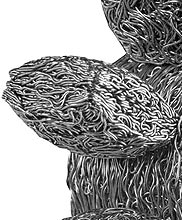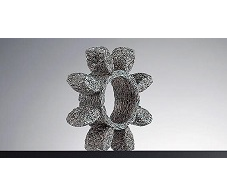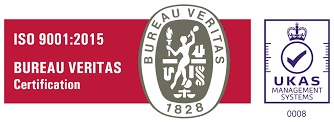The new spider from wire for ROTEX®
The standard material of KTR elastomer spiders is thermoplastic polyurethane for applications in the temperature range between – 30° C and + 90° C. It is produced in different kinds of Shore hardness, depending on the damping capacity on the one hand and torsional stiffness on the other hand. Both parameters are closely linked with temperature.
In order to extend the potential applications of couplings damping vibrations, a spider made from wire knitting was developped for our ROTEX coupling. Damping as a primary characteristic of ROTEX remains the same and the characteristic figures of torque capacity and torsional stiffness remain almost invariable even under permanent loads.
The benefits of the knitted spiders mainly become obvious with applications in the high-temperature range of T > 120° C as well as applications in a corrosive environment, since stainless material is used. The spider from wire can be used with steel, cast iron and hard-coated aluminium hubs.
| Your person in charge at KTR |
| Mr.Johannes Deister
T +49 (5971) 798-465
F + 49 (5971) 798-6465
E j.deister@ktr.com |
|
Mr.Michael Brüning
T +49 (5971) 798-387
F + 49 (5971) 798-6387
E m.bruening@ktr.com |
Technical data

| Technical data |
| Size |
Torque [Nm] |
| ROTEX |
Rated torque
TKN |
Max. torque
TKmax |
Alternating torque
TKW |
| 14 |
12,5 |
25 |
3,3 |
| 19 |
17 |
34 |
4,4 |
| 24 |
60 |
120 |
16 |
| 28 |
160 |
320 |
42 |
| 38 |
325 |
650 |
85 |
| 42 |
450 |
900 |
117 |
| 48 |
525 |
1050 |
137 |
| 55 |
685 |
1370 |
178 |
| 65 |
940 |
1880 |
244 |
| 75 |
1920 |
3840 |
499 |
| 90 |
3600 |
7200 |
936 |
| Permissible displacements |
| Size |
max. axial
ΔKa [mm] |
max radial with
n=1500 1/min ΔKr [mm] |
max. angular with
n=1500 1/min ΔKw[°] |
| 14 |
-0,5 / +1,0 |
0,15 |
1,0 |
| 19 |
-0,5 / +1,2 |
0,10 |
1,0 |
| 24 |
-0,5 / +1,4 |
0,14 |
1,0 |
| 28 |
-0,7 / +1,5 |
0,15 |
1,0 |
| 38 |
-0,7 / +1,8 |
0,17 |
1,0 |
| 42 |
-1,0 / +2,0 |
0,19 |
1,0 |
| 48 |
-1,0 / +2,1 |
0,23 |
1,0 |
| 55 |
-1,0 / +2,2 |
0,24 |
1,0 |
| 65 |
-1,0 / +2,6 |
0,26 |
0,9 |
| 75 |
-1,5 / +3,0 |
0,30 |
0,9 |
| 90 |
-1,5 / +3,4 |
0,32 |
0,9 |
The displacement figures mentioned are maximum figures which must not arise in parallel. If radial and angular displacements arise at the same time, the permissible displacement figures may only beused proportionally.









